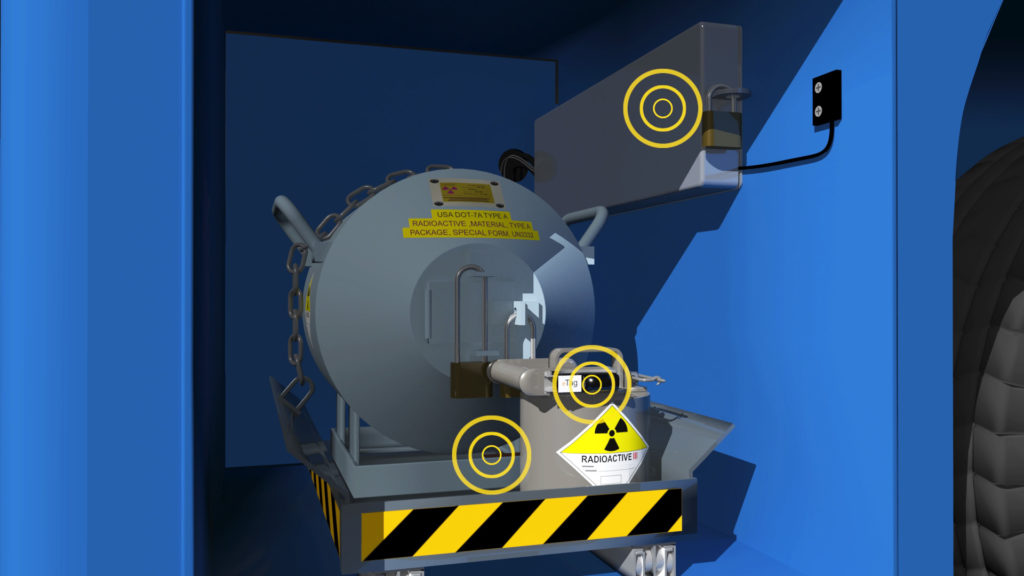“The system is a first line of defense against radiological terrorism and provides situational awareness if the material is tampered with or moved from where it is supposed to be,” said PNNL MSTS project manager Brian Higgins.
According to the Nuclear Regulatory Commission, most radiological dispersal devices would not release enough radiation to kill people or cause severe illness. But they certainly could create fear and panic, contaminate property and require potentially costly cleanup. The National Nuclear Security Administration sponsored PNNL to develop the MSTS system to help protect such material from theft, loss, or tampering.
Radiological sources are commonly used in the oil and gas industries. These sources help determine and log geological features of an oil well, such as porosity or proximity to oil. Other devices with radiological material are commonly used for industrial radiography where devices are used to inspect welds on jobsites. PNNL used its extensive radiological and radio frequency expertise to develop the MSTS system, which consists of detection devices and radiofrequency tags specifically designed to track the devices that house this radiological material.
“Technology transfer to industry is an important mission of the Laboratory, especially in the area of nuclear security where the consequences can be severe,” said Kannan Krishnaswami, who manages commercialization of national security technologies for PNNL. “Partnering with industry allows for such security solutions to be commercially deployed, allowing PNNL to refocus its efforts on the next generation of scientific and technical challenges.”
Golden Security Services will produce the system and make it available to companies that manage the estimated thousands of radiological sources internationally. Golden Security Services has an exclusive license to commercialize the technology in Latin America — Mexico, Central America and South America — and non-exclusive rights to the technology in the United States and Canada.
“We are very excited to have several contracts already in place in Latin America to deploy this technology, and an overwhelming interest from a broad range of companies that are looking for a cost-effective solution to protect their radiological sources across the region,” said Juan Bernal, CEO at Golden Security Services. “PNNL’s technology is a valuable addition to our portfolio of products and services designed to provide physical protection to radioactive materials around the world.”
An oil well mapping truck can travel several hundred miles from its home base. The radiological sources are shielded in specialized casks and moved in trucks that meet Department of Transportation requirements. MSTS sensor technology and associated software can determine when a radiological source moves from where it’s supposed to be and alerts officials. Components of the system work together to control and secure the sources from home base, to the field and back.
The MSTS can also detect changes in radiation levels, which can indicate a source has been taken from its shielding cask. Likewise, a master control unit monitors sensors and runs decision processing software to detect any tampering with or removal of the radiological material. Global Positioning Systems track the location of the transport vehicle to and from the job site. All data are available to system users through a custom MSTS software.
PNNL partnered with Baker Hughes, an international oil field services company, to understand the issues and balance operational needs with national security concerns.
NNSA’s Office of Radiological Security, whose mission is to protect, remove and reduce industrial radiological sources, completed more than a dozen deployments of MSTS in the United States and is now assisting international partners in securing their mobile radiological sources. Golden Security Services is part of that effort.
“Seeing actual products go out in the field feels good,” said PNNL’s Kurt Silvers, who is a lead engineer with the MSTS project. “We developed and then made these systems more rugged to withstand the elements on job sites.”
Software engineer and team lead Brion Burghard added, “It’s gratifying to see Golden Security Services take our technology and software to the next level and make MSTS available to companies who desire a better way to protect the radiological material they are responsible for.”
About PNNL
Pacific Northwest National Laboratory draws on signature capabilities in chemistry, Earth sciences, and data analytics to advance scientific discovery and create solutions to the nation’s toughest challenges in energy resiliency and national security. Founded in 1965, PNNL is operated by Battelle for the U.S. Department of Energy’s Office of Science. DOE’s Office of Science is the single largest supporter of basic research in the physical sciences in the United States and is working to address some of the most pressing challenges of our time. For more information, visit PNNL’s News Center. Follow us on Facebook, LinkedIn, and Twitter.
About Golden Security Services
Golden Security Services (GSS) is the global leader in the physical protection of radioactive materials GSS began its operations in 2004 as an international provider of turnkey solutions for the Global Threat Reduction Initiative (GTRI), today part of the NNSA’s Global Material Security program. GSS has supervised the construction of two central storage facilities (CSF) in Latin America and the Caribbean, has led international efforts to consolidate more than 30 high activity radioactive sources and has implemented rapid security upgrades (including monthly monitoring and long-term quarterly maintenance) to more than 300 sites that operate radioactive materials across seventeen countries around the world. For more information, visit GSS’ Website. Follow GSS on Twitter.
Original post https://alertarticles.info



